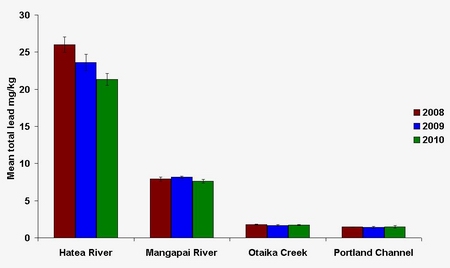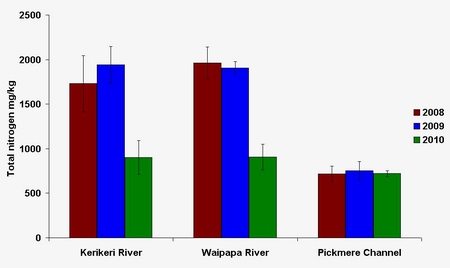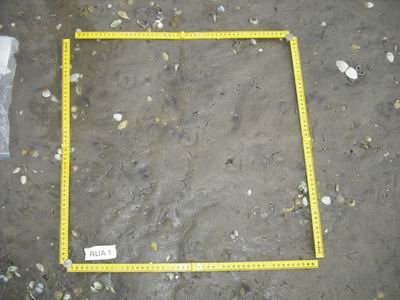Key points 2010-2011
Within this section…
· Whāngārei harbour, Kerikeri Inlet, Ruakaka estuary, Whangaroa Harbour and Kaipara Harbour were monitored.
· Tidal creeks generally had higher proportions of mud, nutrients and metals compared to sites in more exposed environments.
· Metal sediment concentrations were generally within the ANZECC guideline values.
· Some metal concentrations in sediments at sites in Whāngārei harbour and Kerikeri Inlet were higher than similar monitoring programmes elsewhere in New Zealand.
· Overall sediment nutrient levels were higher than similar programmes run by other regional councils in New Zealand and were at levels which indicate that some sites are ‘enriched'.
· Although the elevated nitrogen concentrations in sediments are still of concern, the levels at some sites were significantly lower than concentrations recorded in 2008 and 2009.
· Biological communities at different sites within each estuary were distinctly different from each other. The physical and chemical properties of the sediment explained a relatively large amount of the variation in the community structure.
Metals
In 2010, sediment metal concentrations were within ANZECC guidelines at all of the monitoring sites, except for the concentration of nickel recorded at Kerikeri Inlet. Although the concentrations were generally within guideline levels, concentrations of copper and zinc in the Hātea River in Whāngārei were relatively high compared to levels reported in similar monitoring programmes elsewhere in New Zealand.
Concentration of chromium, copper, nickel and zinc in Kerikeri Inlet were also higher than similar monitoring programmes monitored by other regional councils elsewhere in New Zealand. Runoff from roading, urban areas, agricultural and horticultural land, and stormwater discharges are all likely sources of metal contamination in these systems.

Figure 1: mean lead concentration in sediments collected from three sites in Whāngārei Harbour during 2008-2010.
Changes in metal contaminant concentrations over time have been seen at some sites (Figure 1).
- Whāngārei Harbour – chromium sediment concentrations measured in the Hātea River were significantly lower in 2010 than in 2008.
- Kerikeri Inlet – nickel concentrations in the Waipapa River were significantly lower in 2010 than in 2008 while lead concentrations at all sites in Kerikeri inlet were significantly higher in 2010 than 2008.
- Ruakaka Estuary – zinc and lead sediment concentrations were lower at both sites in 2010 than in 2008 while nickel sediment concentrations at both sites were higher in 2010 than in both 2009 and 2008.
- Whangaroa Harbour – zinc sediment concentrations at both sites were lower in 2010 than in 2009.
- Kaipara Harbour – copper, zinc and lead concentrations at both sites were lower in 2010 than in 2009.
Nutrients
There are currently no national guideline values for nutrient sediment concentrations in New Zealand. However, nutrient concentrations in sediments measured at some sites were higher than similar monitoring programmes elsewhere in the North Island of New Zealand.
Both phosphorus and nitrogen sediment concentrations were highest at sites in the Hātea River and Mangapai River in Whāngārei Harbour, Waipapa River and Kerikeri River in the Bay of Islands and the Kahoe River in Whangaroa Harbour.
These nutrient concentrations are typically higher where wastewater treatment plants, industries, horticulture and stormwater discharge and close to where rural catchments drain into upper estuaries of enclosed harbours. Such high concentrations are considered to indicate that these environments are sediment ‘enriched'. This can lead to excessive plant growth, which can in turn cause a rapid reduction in water quality, harmful algal blooms, shellfish contamination, fish kills and a reduction in biodiversity.
Although nutrient sediment concentrations were relatively high in 2010, there was a significant decrease in nitrogen concentrations at most sites compared to concentrations measured in 2009 and 2008 (Figure 2).
· In Kerikeri inlet, Whangaroa Harbour and Ruakaka Estuary, nitrogen concentrations in 2010 were significantly lower than concentrations measured in 2009 and 2008.
· Phosphorus sediment concentrations in Whangaroa and Kaipara Harbours were also lower in 2010 than 2009 while phosphorus sediment concentrations in Kerikeri Inlet in 2010 were significantly higher than levels recorded in 2008.
It is possible that the decrease was due to the drought that hit Northland during 2009-2010. Further monitoring is needed to determine whether the decrease in nitrogen concentrations is a persistent trend or a short term fluctuation.

Figure 2: mean nitrogen concentration in sediments collected from three sites in Kerikeri Inlet from 2008 to 2010.
Biological communities
The makeup of the biological communities at each monitoring site were found to be distinctly different from each other and differences were also found between the community structures at each site over time.
 Quadrat used for sampling biological communities.
Quadrat used for sampling biological communities.
Analysis of the biological community and the sediment data indicated that a relatively large amount of the variation in the biological community was explained by the physical and chemical properties of the sediment.
In Kerikeri, for example, the sediment chromium and zinc concentrations explained approximately 64 percent of the variation in the community structure. This has important implications as it shows that the quality of the sediment influences the biological communities found in the sediment. Such impacts can be reduced by better controlling those metal concentrations entering our waterways.
